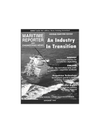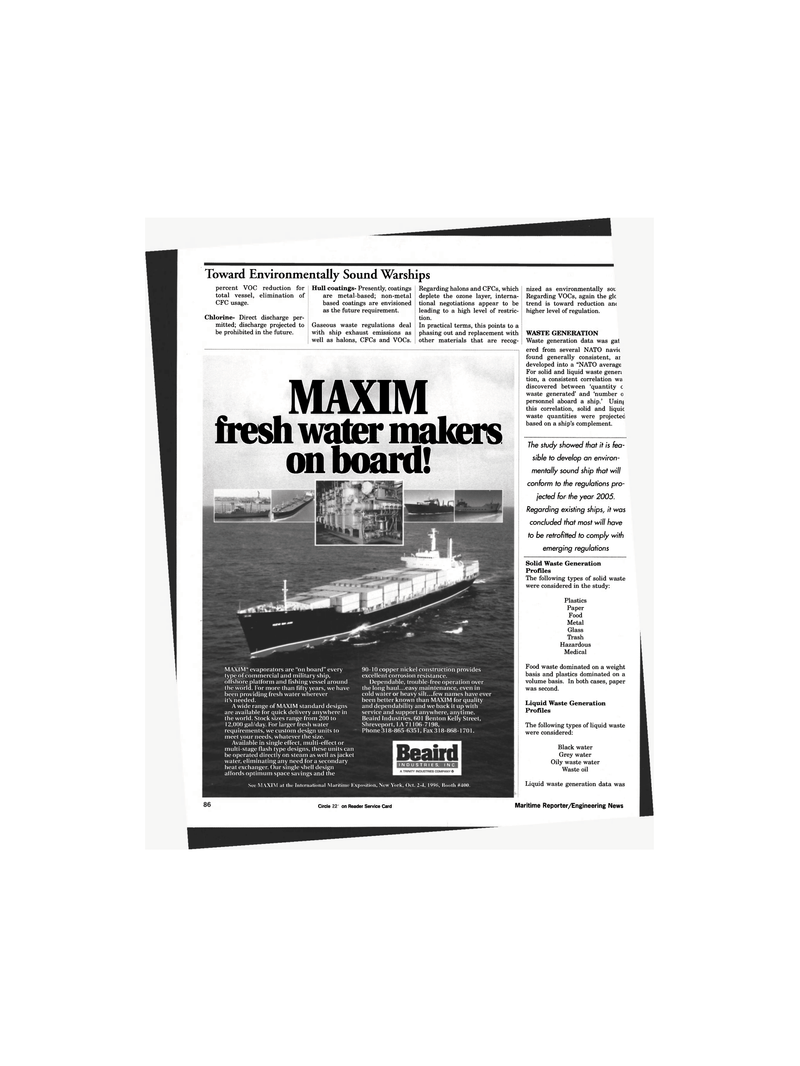
Page 86: of Maritime Reporter Magazine (September 1996)
Read this page in Pdf, Flash or Html5 edition of September 1996 Maritime Reporter Magazine
Toward Environmentally Sound Warships percent VOC reduction for total vessel, elimination of
CFC usage.
Chlorine- Direct discharge per- mitted; discharge projected to be prohibited in the future.
Hull coatings- Presently, coatings are metal-based; non-metal based coatings are envisioned as the future requirement.
Gaseous waste regulations deal with ship exhaust emissions as well as halons, CFCs and VOCs.
Regarding halons and CFCs, which deplete the ozone layer, interna- tional negotiations appear to be leading to a high level of restric- tion.
In practical terms, this points to a phasing out and replacement with other materials that are recog-
MAXIM fresh water makers onboard!
MAXIM® evaporators are "on board" every type of commercial and military ship, offshore platform and fishing vessel around the world. For more than fifty years, we have been providing fresh water wherever it's needed.
A wide range of MAXIM standard designs are available for quick delivery anywhere in the world. Stock sizes range from 200 to 12,000 gal/day. For larger fresh water requirements, we custom design units to meet your needs, whatever the size.
Available in single effect, multi-effect or multi-stage flash type designs, these units can be operated directly on steam as well as jacket water, eliminating any need for a secondary heat exchanger. Our single shell design affords optimum space savings and the 90-10 copper nickel construction provides excellent corrosion resistance.
Dependable, trouble-free operation over the long haul...easy maintenance, even in cold water or heavy silt...few names have ever been better known than MAXIM for quality and dependability and we back it up with service and support anywhere, anytime.
Beaird Industries, 601 Benton Kelly Street,
Shreveport, l.A 71106-7198,
Phone 3 18-865-6351, Fax 318-868-1701.
INDUSTRIES, INC.
See MAXIM at the International Maritime Exposition, New York, Oct. 2-4. 1996, Booth #400. nized as environmentally sol
Regarding VOCs, again the glc trend is toward reduction an< higher level of regulation.
WASTE GENERATION
Waste generation data was gat ered from several NATO navit found generally consistent, ai developed into a "NATO average
For solid and liquid waste gener; tion, a consistent correlation wa discovered between 'quantity c waste generated' and 'number o personnel aboard a ship.' Usinj this correlation, solid and liquic waste quantities were projected based on a ship's complement.
The study showed that it is fea- sible to develop an environ- mentally sound ship that will conform to the regulations pro- jected for the year 2005.
Regarding existing ships, it was concluded that most will have to be retrofitted to comply with emerging regulations
Solid Waste Generation
Profiles
The following types of solid waste were considered in the study:
Plastics
Paper
Food
Metal
Glass
Trash
Hazardous
Medical
Food waste dominated on a weight basis and plastics dominated on a volume basis. In both cases, paper was second.
Liquid Waste Generation
Profiles
The following types of liquid waste were considered:
Black water
Grey water
Oily waste water
Waste oil
Liquid waste generation data was 134
Circle 355 on Reader Service Card Maritime Reporter/Engineering News

 85
85

 87
87
